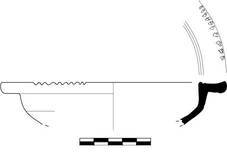
The best summary of the whole site that I found is from the Pre-Construct Archaeology site. This is the private firm that actually did the digging. It looks like they've done a superb job.
As a little bit of an aside, I enjoyed the range of headlines given to the newspaper articles about this find. The following list is drawn from a search in Google news:
- Day-to-day relics reveal Roman London
- Londinium bourgoisie revealed in unique Roman find
- Roman artifacts discovered in London well
- Archaeologists unearth Roman-style dining utensils in London
- Haul of ancient Roman artefacts found in London well stuns experts
- London dig finds history by the bucketful
The last article, from the London Times Online, includes the following image (it's number 5 in the "slide show" at the top of the article):

The deposition of the vessel hoard is dated to after 375 AD by its stratigraphic position above two coins. That makes the metal vessel illustrated above a nice point of comparison with contemporary ceramics. Download this PDF from Lattara 6 and see forms 71 to 76 for African Red-Slip that shares the general idea of a more-or-less deep bowl with wide and more-or-less horizontal rim. Many of the ceramic vessels also have decoration on the outer edges of their rims.
It looks like the metal vessels from Drapers Garden trend larger than their ceramic analogs. That's nice because one can imagine them going well together on a table, though it's somewhat speculative to think that metal and ceramics were mixed when such dishes were laid out for a meal.
Metal in use by wealthier households and African Red-Slip more widely available to folks living somewhat near to the coast and/or a major trade route together led the way in establishing this part of the koine of late Roman table vessels. The general form was further spread by potters collectively less prolific than their North African colleagues. See the first entry in the publication of "Late Roman West Asia Minor 'Light Colored' Ware" at Ilion/Troy (with profile drawing and photograph below). That's an unwieldy name for an interesting ware that almost broke into the front ranks of the ceramic trade. For example, it's found in small amounts at Berenice in present day Libya. The example from Ilion shows the decorative rim edge, though in this instance the motif is not continuous. That's a common feature on ceramic vessels.



No comments:
Post a Comment